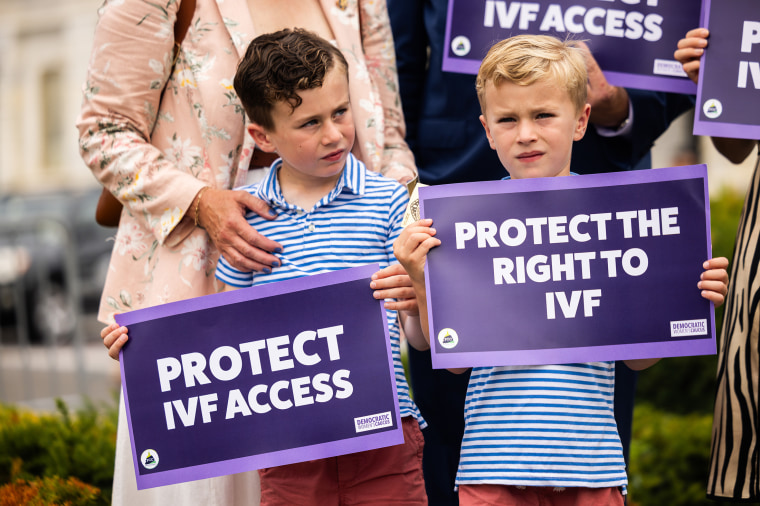President Donald Trump has nicknamed himself “the fertilization president,” but six months after he formally pledged to expand access to in vitro fertilization, the White House has yet to issue a policy to that end.
Since he campaigned on the issue last year, Trump’s push to support IVF has been complicated by backlash from conservatives and anti-abortion groups who see IVF as unethical, as well as members of the “Make America Healthy Again” movement who view the pharmaceutical industry as having undue influence over fertility care.
Many of these groups have instead suggested that Trump redirect his attention to a little-known holistic approach called restorative reproductive medicine. The underlying philosophy is that doctors can identify and treat the root causes of infertility, often with less invasive and more affordable methods than IVF.
But restorative reproductive medicine isn’t formally recognized as a medical specialty in the U.S. and has not been evaluated as extensively as IVF has. Many fertility doctors worry that holistic methods are being presented to patients as a better alternative to IVF, thereby denying patients access to a proven option in fertility care.
“Restorative approaches may work for certain patients, but elevating them as morally superior or universally preferable undermines the individualized, evidence-based care modern reproductive medicine is built on,” said Dr. Brian Levine, the founding partner of CCRM Fertility of New York.

After Trump issued an executive order in February promising to make IVF more affordable and attainable, Republican lawmakers introduced companion bills in the House and Senate that would expand access to restorative reproductive medicine and prohibit discrimination against providers who don’t offer IVF. And in June, Arkansas became the first state to require insurance companies to cover restorative reproductive medicine treatments.
Recent actions out of the Department of Health and Human Services suggest an aligned interest in holistic fertility methods. Calley Means, a special government employee at HHS, told Fox News in April that there was a “mandate from the top” to come up with “a holistic fertility policy.” That same month, HHS laid off the team responsible for tracking IVF success rates as part of the agency’s massive restructuring.
Then in July, HHS posted a grant opportunity for an “infertility training center” that would educate people on a “broad range of holistic infertility treatments.” The proposed center would draw from federal Title X funds, which have historically been used to provide birth control or testing for sexually transmitted diseases.
Andrew Nixon, a spokesperson for HHS, said the agency released a forecast for a future funding opportunity but is not currently soliciting applications for an infertility training center.
“HHS is committed to prioritizing helping couples suffering from infertility,” Nixon said, pointing to Trump’s executive order on IVF.
Some IVF supporters say they sense indecision within the Trump administration over how to proceed with a federal policy, despite the president calling himself the “father of IVF.” (Decades of research laid the foundation for IVF, but the first successful IVF pregnancy took place in England in 1978.)

The White House Domestic Policy Council, which advises the president on domestic issues, presented Trump with policy recommendations for supporting IVF in May. Dr. Kaylen Silverberg, an adviser to that council and a fertility specialist at Texas Fertility Center, said he recommended to White House officials that they declare infertility an essential health benefit under the Affordable Care Act and cover IVF services for military and government employees.
But The Washington Post reported Sunday that the White House does not plan to require health insurers to cover IVF services, a policy Trump previously said he would implement.
Silverberg said White House officials haven’t told him which policies they favor.
“They come at me with very insightful questions, but they don’t give me anything,” he said. “If I say to them, ‘Hey, what are you thinking about such and such?’ The pat answer that I get back is, ‘Well, we’re listening to lots of different sources, and we’re trying to formulate the best solutions that we can.’”
The White House said it has met with stakeholders across the spectrum to solicit their input.
“President Trump pledged to expand IVF access for Americans looking to start families, and the Administration remains committed to delivering on that pledge and exploring all options that address the root causes of infertility,” White House spokesman Kush Desai said.
Restorative reproductive medicine may indeed be one of those options. The International Institute for Restorative Reproductive Medicine, the professional association for doctors who offer this type of fertility care, has spoken with federal officials about its methods, said Dr. Tracey Parnell, the institute’s global director of communications and development.
Parnell, who is Canadian, coined the term “restorative reproductive medicine” in the late 1990s alongside a small group of international physicians. She was surprised earlier this year when her community became part of the national conversation in the U.S., she said.
“We were sort of expecting another decade to be able to get to the stage of more published information and further along the pathway to formal recognition as a specialty,” Parnell said, noting that such recognition in the U.S. requires accreditation by a national board.
One group responsible for increasing the visibility of restorative reproductive medicine is the Heritage Foundation, a conservative think tank whose policy proposals are known to influence the White House’s agenda.
In March, the foundation published a report highlighting what it said are the benefits of restorative reproductive medicine over a fertility industry that “profits from the creation and selection of human life.” The report emboldened groups that are morally or ideologically opposed to IVF, said Levine, of CCRM Fertility.

“Part of the ultra-right-wing personhood movement has taken advantage of this opportunity that IVF is now ubiquitous in all of our conversations, to now jump in and say that they believe that there is a better alternative than IVF itself,” Levine said.
Many members of the “Make America Healthy Again” movement, led by Health Secretary Robert F. Kennedy Jr., also favor holistic methods.
In late June, the Heritage Foundation and the MAHA Institute — a policy center that backs initiatives that align with the MAHA movement — held a roundtable discussion on women’s fertility. Many of the speakers there advocated for restorative reproductive medicine and warned of the risks of hormonal birth control. At least one high-powered federal official, the Food and Drug Administration’s principal deputy commissioner, Sara Brenner, was in attendance and expressed support for the topics discussed.
“The goals of the Make America Health Again movement — to return to holistic, root-cause medical care for men and women — align with the goals and approach of restorative reproductive medicine, even if there are notable differences and distinctions between those two movements,” said Emma Waters, a policy analyst at the Heritage Foundation.
Parnell, of the International Institute for Restorative Reproductive Medicine, said the group’s methods don’t prevent people from pursuing IVF, but rather give them options.
Practitioners of restorative reproductive medicine say their methods are individualized to the patient and don’t rush to diagnose women with infertility if they can’t conceive right away. They often ask patients to carefully track their menstrual cycles, body temperature and changes in cervical mucus to help determine when they’re ovulating. They also look to diagnose and treat medical conditions that may impact fertility, such as polycystic ovary syndrome or endometriosis.
Where necessary, practitioners may suggest changes to patients’ diets, recommend vitamins or supplements or prescribe hormone medications that improve ovulation. In some cases, they may advise surgery to diagnose endometriosis and remove scar tissue that can block an egg’s path to the uterus.
But IVF doctors said the restorative approach can take time, which some patients may not have if they have a diminished number or quality of eggs. Many of the tactics of restorative reproductive medicine, like prescribing hormones or dietary changes, are already used in fertility clinics nationwide, they added.
Silverberg, of Texas Fertility Center, said restorative reproductive medicine is “a made-up term for something that’s been going on for decades.”
“My concern is that the people who focus solely on restorative reproductive health want things to stop right there. They unfortunately advocate ignoring all of the medical advances that have happened in the last 40 years,” Silverberg said, adding that he shared these thoughts with White House officials.
Monica Minjeur, the U.S. director of communications and development for the International Institute for Restorative Reproductive Medicine, said there is data to show that the approach works. In a study of more than 400 women with a history of infertility, most of whom had been unsuccessful with IVF, roughly 32% gave birth after turning to restorative reproductive medicine. The odds of having a child via an additional cycle of IVF were roughly the same, according to the paper, which Parnell co-authored. (The average success rate of a woman’s first IVF cycle is around 30%.)
Despite its conservative fan base, Minjeur said, restorative reproductive medicine is not inherently political or religious, and her organization is cautious about these associations.
“We are a science-based medical organization who is trying to just get the good word out to the people,” she said. “If and where that aligns with government priorities to help people who want to build families, great, we’ll take it.”


